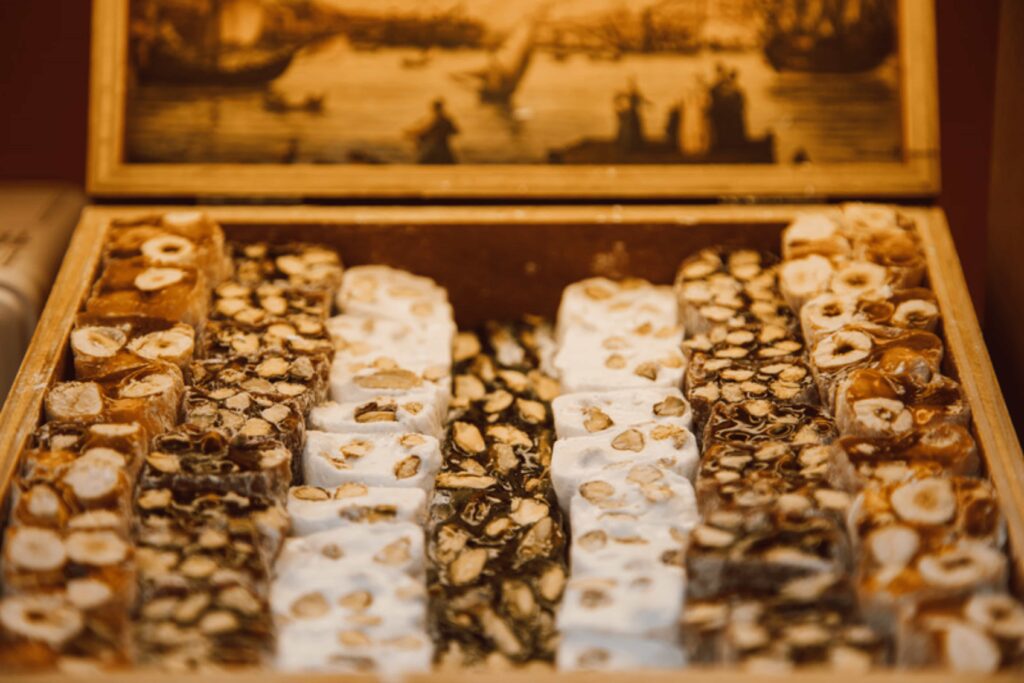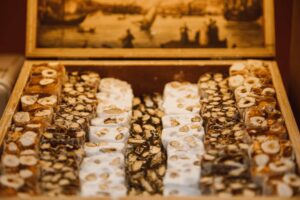The taste of nougat is both crisp and firm, with rich milky and nutty aromas bursting out. With the crispy chewing, you can satisfy your desire for a variety of snacks at one time, plus the fresh color, which is addicting, endless aftertaste, praise I can’t stop talking. It is deeply loved and popular by the public, especially the best choice for children’s snacks. Although there are many varieties of nougat, modern versions of nougat can be divided into two types, hard and soft, depending on the ingredients and cooking time. Nougat made from honey has a soft texture, while nougat made from sugar has a firm texture.
The history of Nougat
Nougat is also known as Bird’s Candy, and people in Macau call it Nougat or Brown Candy. Nougat tastes sweet in the mouth, with a strong aroma of peanuts and milk, and it is very chewy. The more you chew, the more fragrant it is. There are many theories about the origin of nougat, and many countries have related records a long time ago. , it is not difficult to find that the nougat practices in each place are slightly different, each with its own characteristics. The following lists the origins of nougat in various places.
Italian Torrone
“Torrone” in Italian usually refers to soft nougat, usually made of honey, sugar and egg whites, and served with toasted almonds or other nuts. It first appeared in the 15th century at the wedding celebrations of Cremona, Lombardy in Lombardy. Made into a rectangle according to the shape of the bell tower of the Cathedral of Cremona, it was called Torrazzo or Torrione at that time, which may be the origin of the name Turonose.
French Nougat
French nougat has been produced in Provence since at least the sixth century. In the Middle Ages it was known as “nogat”. There are two recipes, a traditional crunchy black nougat made without eggs, and the famous soft nougat Nougat de Montélimar (Montélimar nougat) with lavender honey , almonds and pistachios. Black and white nougat is one of the 13 traditional desserts at Provence Christmas.
Spain Turrón or Torró
Nougat is called “Dulon” in Spain. It is said that it was introduced by the Arabs and produced in Jijona for more than 500 years, mainly for Christmas. Durons are divided into two categories, Turrón blando de Jijona and Turrón duro de Alicante. Hard duron is made from toasted almonds, pure honey, sugar and egg white, with a milky white appearance and a firmer texture; soft duron is processed and softened into a texture similar to peanut butter. Color is light brown.
Iran Gaz
The Iranian version of nougat also has a long history, and people like to give each other gaz during New Year . Iranian gaz is made with gaz sugar, egg whites, almonds or pistachios mixed with rose water. The biggest difference between Iranian nougat and nougat in other parts of the world is that the sweetness does not come from sugar or honey, but from gaz-angebin, a unique local desert plant.
Asian Nougat
The Chinese Ming Dynasty Juren Shang Ju (according to the Ming Dynasty orthodox ten-year meeting and the palace test are all ranked first) in order to thank Emperor Wenchang for his dream to make it three yuan and the first, according to the practice in the dream. It is made of maltose, peanuts, rice, etc. and kneaded into the shape of a cow, so it is called nougat, but later because it is not easy to knead sugar into the shape of a cow, and the production speed is slow, so it is directly cut into a rectangle. sell. Later, foreign missionaries spread this candy to the West, and it became one of the most popular candies in foreign countries.
There is also a saying that nougat is a trophy brought back by the Crusades. For hundreds of years, nougat has drifted from the East to the West, and from the West back to the East. Nougat has a place in the French pastry industry hundreds of years ago. King Louis XV of France visited the Spanish royal family, not with gold or jewelry, but with 42 kilograms of nougat, which is enough to prove that nougat was in the past. value. Nougat, also known as Nougat in France, the French brought back nougat from the East when the crusades in the 11th and 12th centuries. The original recipe was walnuts and honey, but the French decided to add pistachios, almonds and cherries. . Delicious nougat soon set off a boom in France. So far, the cities in southern France produce 2,000 metric tons of nougat every year, which is the city with the largest production volume.
In modern times, it is generally believed that “Nougat” is a transliteration of “Nougat”. After nougat became popular in Taiwan, the locals improved the original formula and used a lot of milk powder as one of the main raw materials, which made the taste more dense and full of milky fragrance. The matching nuts are no longer a single almond and peanut. People will add a variety of different ingredients, such as pistachios, hazelnuts, walnuts, dried cranberries, dried mangoes, various candied fruits and even petals. Since then, Taiwanese nougat has become a local feature, and many tourists will buy Taiwanese nougat of various flavors as a gift for relatives and friends.
The practice of Peanut Nougat
The final quality characteristics of nougat are three types: toughness, brittleness and sandiness. The method of processing brittle and sandy sugars is basically the same as that of tough nougat; for sandy nougat, cocoa powder and powdered sugar should be added together with melted stearin. Sandy nougat, refined from fresh and pure milk, is sweet but not greasy.
[Main ingredients]: 800 grams of peeled raw peanuts, 1/2 cup of water, 400 grams of caster sugar, 400 grams of thick maltose, 2/3 tsp salt, 2 egg whites, 1 sheet of non-stick parchment paper, 1 pack of transparent candy paper
Step:
- First roast the peanuts at 150°C until golden brown and crispy, turning them from time to time to avoid uneven heat, about 15 minutes.
- Put the syrup ingredients in a small pot, boil over medium heat, and cook to 143°C. If you don’t have a thermometer, drop a drop of syrup into cold water, and it’s ready to cook if it forms a hard lump.
- At the same time, beat the egg whites until stiff peaks, then pour in the boiled sugar and continue beating.
- Stop when the surface of the syrup loses its luster, so that the finished product is not easy to soften and soften. (Hot water must be placed below, otherwise the sugar will solidify quickly) Add peanuts and stir slowly until the sugar cubes feel dry and not sticky when touched by hand.
- Pour the whole piece onto parchment paper, wrap it well, and press it into a flat square about 1.5 cm thick.
- Use a kitchen knife to cut into long strips and wrap them in candy paper.
Tips:
- It is best to use an electric mixer. If you do it manually, the speed is not fast enough, and the sugar will coagulate quickly, which is very laborious.
- When the syrup is boiled, if it is less than 143 degrees, the prepared sugar will be softer.





One Response
I like this blog very much, Its a really
nice post to read and find information.Raise range